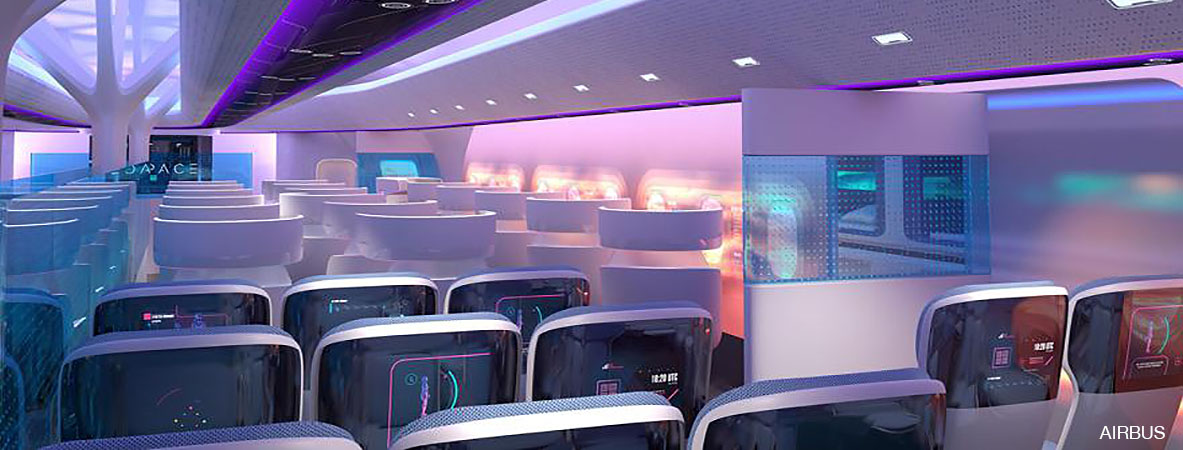The area of an airplane passengers know best, is – without a doubt – the cabin. The entire trip takes place there, and it must be comfortable and pleasant for the passenger. It should also be spacious, with enough room for hand luggage and for movement of both crew and passengers. Last, but not least, the cabin must be safe, in terms of both structure and environment – now, more than ever, given the current health crisis.
Aeronautical manufacturers are concerned about efficiency, but they also invest plenty of resources – and large doses of imagination – in ergonomics and passenger comfort.
Therefore, aircraft manufacturers are constantly seeking to improve this space. One recurring challenge is how to use space more efficiently while improving passenger comfort, so travellers will want to repeat the experience.
As mentioned, one of the most important aspects of cabin design is taking advantage of space. Materials have evolved to make it possible to design seats that are slimmer, yet just as strong. This makes it possible to increase the space available for each passenger while maintaining – or even improving – comfort.
This can also be achieved by designing seats in different shapes. Some airlines are looking for ways for passengers to sit in more upright positions, especially on shorter flights. This could make more rows of seats possible, depending on the model.
On the other hand, there are designs that propose new ways of reorganising cabin space; for example, placing rows of seats facing each other with a table in between them, as on trains. Another option is a long table that stretches the length of the cabin with seats on both sides, which could serve as a new type of business class.
An extreme option would be seats that could be geometrically reconfigured between flights. These would be folding seats, on rails, that could be connected to each other in ways that maximise space depending on the needs of each flight.
Another important approach to the design of future cabins aims to improve the passenger experience. One way to achieve this is by modifying the cabin environment. One way to do this would involve more windows or increasing window size for better views, as in the Airbus design vision for 2050. Decades ago, this could have been challenging, but today things like this are possible thanks to advances in structural design and more efficient materials used in aircraft.
For those advocating a more virtual approach, some manufacturers are considering digital windows. Screens – covering a greater or lesser area of the cabin’s interior – would offer views identical to those seen through a glass window and could also project multimedia content for passengers.
When luxury is the aim, there is are more options, including a wide variety of furnishings to improve flight quality. This could range from screens to refrigerators, to individual tables and even armchairs and beds.
There are even more unusual ideas: cabins that replicate famous capsule hotels, in which each passenger travels lying down inside their own enclosed space. This gives passengers more space than a conventional seat and is comfortable for sleeping on long haul flights – but this idea could be affected by the development of new supersonic models, that shorten even the longest flights.
In any case, all of the aforementioned solutions can be partially implemented in mixed-design cabins, the same way different classes coexist on flights today. The implementation of each one largely depends, as mentioned, on the type of aircraft, the normal route it covers and the type of passenger it serves.
In a more global way, considering the cabin as a whole, there are solutions such as the modular cabin, a design patented by Airbus a few years ago. The idea is to use cabins that detach from the plane upon landing, and then couple with a plane that is ready to take off. This would reduce time between flights, making it easier to reconfigure these cabins during stops, using some of the previously mentioned options.
In addition to these physical aspects there are new challenges, such as those related to CoVid-19 which require maintaining a certain distance between passengers.
Some of these proposals will become reality in the next few years. Without a doubt, manufacturers are betting on this, and this can be seen in their designs for coming decades. This is what happened with winglets or sharklets (depending on the company that installs them), each manufacturer will use different designs depending on their models. But one thing is sure: as passengers, before we know it, we will be enjoying the benefits of future-style cabins.



